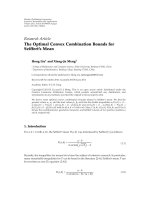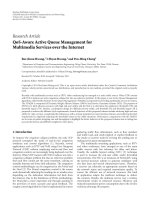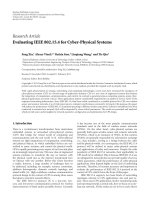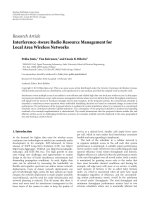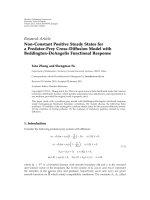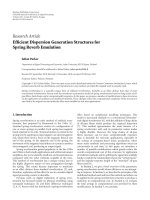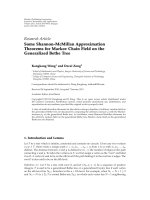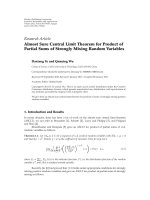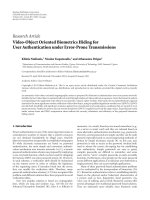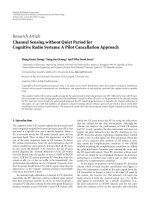Báo cáo hóa học: " Research Article Physically Motivated Environmental Sound Synthesis for Virtual Worlds" pdf
Bạn đang xem bản rút gọn của tài liệu. Xem và tải ngay bản đầy đủ của tài liệu tại đây (764.67 KB, 11 trang )
Hindawi Publishing Corporation
EURASIP Journal on Audio, Speech, and Music Processing
Volume 2010, Article ID 137878, 11 pages
doi:10.1155/2010/137878
Research Article
Physically Motivated Environmental Sound Synthesis for
Virtual Worlds
Dylan Menzies
Department of Media Technology, De Montfort University Leicester LE1 98H, UK
Correspondence should be addressed to Dylan Menzies,
Received 3 May 2010; Accepted 10 December 2010
Academic Editor: Andrea Valle
Copyright © 2010 Dylan Menzies. This is an open access article distributed under the Creative Commons Attribution License,
which permits unrestricted use, distribution, and reproduction in any medium, provided the original work is properly cited.
A system is described for simulating environmental sound in interactive virtual worlds, using the physical state of objects as
control parameters. It contains a unified framework for integration with physics simulation engines and synthesis algorithms that
are tailored to work within the framework. A range of behaviours can be simulated, including diffuse and nonlinear resonators,
and loose surfaces. The overall aim has been to produce a flexible and practical system with intuitive controls that will appeal to
sound design professionals. This could be valuable for computer game design and in other areas where realistic environmental
audio is required. A review of previous work and a discussion of the issues which influence the overall design of the system are
included.
1. Introduction
In everyday life, we experience a range of complex sounds,
many of which are generated by our direct interaction
with the environment or are strongly correlated with visual
events. For example, we push a pen across the table, it
slides then falls off the table, hits a teacup, and rattles
inside. To generate even this simple example convincingly
in an interactive virtual world is challenging. The approach
commonly used is simply to match each physical event to a
sound taken from a collection of prerecorded or generated
sample sounds. Even with plentiful use of memory, this
approach produces poor results in many cases, particularly
in sections where there is continuous evolution of the sound,
because the possible range of sounds is so great, and our
ability to correlate subtle visual cues with sound is acute.
Foley producers have known this for many years. When the
audio-visual correlation is good the sense of realness and
immersion can be much better than either audio or visuals
alone. Conversely, when the audio-visual correlation is poor,
this can worsen the experience. In the interactive case where
we have the ability to control the sound objects make, this
correlation becomes more critical, as our attention is more
acute.
The phrase physically motivated audio is used here as
short-hand for the use of the macro physical state of
the virtual world to provide the controlling information
for the underlying audio processes. The audio processes
model microphysical behaviour that consist of the audio
vibrations and physical behaviour too fine to be captured
by the macro system. The macrophysical interactions that
can occur in virtual worlds can be managed by integration
under constraints, for which there exists a large literature
and a range of dedicated physics engine software libraries,
both commercial and open source. These implement a wide
range of techniques, but appear broadly similar to the
application developer, with some differences of interface and
data organization.
In the context of virtual environments, procedural sound
or generative sound refer to algorithmic sound synthesis
in general. This includes synthesis that is not visually or
haptically correlated, but can be parameterized and coded
compactly. Weather sounds for example require constant
variation and controls for selecting the current prevailing
conditions. The advantages must be weighed against the
quality of the sound compared with sample-based sound.
If there is no audio-visual correlation, procedural sound
may not be preferable to sampled sound. In the following,
2 EURASIP Journal on Audio, Speech, and Music Processing
we focus on physically motivated sound, where the advan-
tages of procedural approach are clear.
2. Review
Examples of physically motivated audio can be found in the
early computer games, such as Asteroids in which physically
modelled collisions occur between objects moving in zero
gravity (Asteroids is a video arcade game released in 1979
by Atari Inc., conceived by Lyle Rains and programmed
and designed by Ed Logg. We overlook the fact that sound
cannot travel in empty space!). Hahn et al. presented a
dedicated rendering framework for sound in conjunction
with computer animation, including examples such as
multiple impacts on a drum [1]. Van den Doel et al. provided
the first detailed sound synthesis examples driven by a
rigid body physics simulation [2] that included continuous
contact interactions as well as impacts. Object resonance
is modeled with modal resonators, which had previously
been successfully applied in musical applications simulating
struck objects [3]. The parameters for a modal resonator
can be very compact. 0.1 KB is enough to encode 10 modes
whereas 100 KB is required to store 1 second of CD quality
audio. Also, the spectral output of a modal resonator can vary
constantly because the states of the modes are independent.
This variation is often subtle, but it reproduces an important
audio signature found in real resonators, which would be
very expensive to emulate with samples. The surface is
modelled using a profile that is resampled according to the
speed of the contact relative to the surface and then filtered
to reflect the amount of slippage, which is the relative speed
of the surfaces at the contact. If surfaces are just slipping
or scraping, there is little or no filtering. If the surfaces roll
over each other, there is no slippage, and the interaction is
less energetic. This is reflected with filtering that attenuates
higher frequencies.
This work has opened up avenues for further develop-
ment and improvement. The original contact model does
not work well with more complex profiles, because at
lower speeds, micro impact are smoothed out, while for
real surfaces, micro impacts generally retain some impact
character at lower speeds. More physically detailed contact
models have been developed that include the instantaneous
interaction between resonating components in contact [4].
These can generate very good results for some kinds of
interaction, but are computationally more complex, and
prone to instability. Being physically explicit, they are not
easily tailored to fit the behaviour desired by a sound
designer. Any framework supporting such contact models
would need to closely couple the resonating objects, which
would greatly complicate the design. It is possible that future
physics engines may be sufficiently precise to implicitly
execute models such as these; however, given that engine
development is mainly driven by graphics, this is unlikely in
the near future.
There are many interesting surfaces that are not fixed,
such as gravel, crumpled foil, sand, leaves, and water. These
would be expensive to model as part of the macro physical
simulation, and so simplified models that provide good
audio results are sought. In the case of water, the sound
from many individual bubbles has been synthesized. On
its own, this approach is not very convincing and quite
expensive [5]. With a fluid dynamics simulation controlling
the bubbles, the sound is very realistic but very expensive [6].
Clearly, there is a need for an inexpensive approach that is
convincing and can be modified by the sound designer in a
flexible way with reference to recordings. Cook has provided
examples of synthesis of foot fall on loose surfaces, made
by analyzing recorded surface sounds to generate parameters
for filtered granular processes [7]. It would be valuable to
adapt these kind of techniques to a physics-enabled virtual
world.
Modal resonators are very efficientatmodellingobjects
that have a few prominent modes, such as ceramic and
metal blocks and containers. Modes can be fitted readily to
recordings of such real objects being struck, and each mode
has intuitive control parameters, amplitude frequency, and
damping. Modes are easily removed or added to simplify
or enrich a resonator. Modal resonators are less suitable for
more diffuse resonances that are often encountered, such
as wooden furniture or large metal panels. In addition,
many resonators exhibit noticeable nonlinear behaviour
causing pitch glides, spectral migration, or internal buzzing
or rattling effects, which would add interest and realism.
Research in musical synthesis provides examples that address
some of these problems using synthesis methods such as 2D
waveguides [8] and finite elements [9],butatmuchgreater
cost. More recently, nonlinear interaction between modes
has been shown effective for synthesizing environmental
sounds, but with significantly higher costs compared with
linear modes [10, 11]. Resonator models are needed that can
generate this range of behaviour with the high efficiency,
stability, and flexibility required of a virtual world. This
may require some compromise of sound quality, which is
acceptable for a virtual world setting although possibly not
in a musical one.
3. Phya, a Library for Physically
Motivated Audio
A framework should facilitate the appropriate signal flow
between audio processes and manage the resources. The
user should be protected as far as possible from the internal
workings including communication with the physics engine
and should only have to specify the audio properties of
the objects in the virtual world. The software library Phya
[12, 13] (online materials are accessible from
.dmu.ac.uk/
∼dylan/) has been developed to meet these
requirements and includes a range of audio processes that
address the limitations cited in the last section. C++ is chosen
as the main language for simplifying use with physics engines
and applications (there is now a Java port by Sam Bayless,
JPhya hosted at Google Code, created for the Golems Univer-
sal Constructor application />Van den Doel has also developed a Java framework, JASS
[14], which provides useful set of objects for building audio
processes. However, it has not addressed the problem of
EURASIP Journal on Audio, Speech, and Music Processing 3
Application
Phya
Audio thread
Phya integration Physics engine
Figure 1: Components in a Phya application. Arrows point in the
direction of function calls.
integration with a physics engine, or the further development
of audio processes.
For sound designers who are not programmers, it is
necessary to provide graphical interfaces that expose the
underlying programming interface in an interactive environ-
ment for authoring object audio descriptions and a way to
import these descriptions into Phya. The more interactive the
interface, the faster the design process becomes. This need
has been considered by an associated project called VFoley
[13] in which objects can be manipulated in a virtual world,
while audio parameters are adjusted.
Before discussing the details, we pause to make some
general observations. In principle, sound in a virtual envi-
ronment can be reproduced accurately through detailed
physical modelling. Even if this were achieved, it is not
enough for the Foley sound designer, who needs to be able
to shape the sound according to their own imagination and
reference sounds: explicit physical models are often difficult
to calibrate to a desired sound behaviour although they
are controlled directly by physical parameters. The physics
engines used are too coarse to calculate audio directly.
The audio behaviour is a property of the overall system,
including the physics engine. In this mixed arrangement, the
connections and management of parts actually processing
audio signals are as relevant as the audio processing. So, the
description of the system is by necessity partly mathematical
and partly relational. (Depending from which disciplinary
bias the reader comes, they may complain this is either too
descriptive, or too mathematical!)
Physical principles guide the system design, combined
with judgements about what is perceptually most relevant.
This has previously been a successful approach in physical
modelling of acoustic systems. A simple observation can
lead to a feature that has a big impact. Evaluating a sound
generator objectively is not straightforward. A generator is
a function returning sound histories from input histories,
which is a much more complicated object than a single
sound history, a sample. This is what makes modelling so
interesting. Nor is it clear how to generalize features that are
important, and it may be that no such generalization can
easily be made. Even if this could be done, would it be all that
useful? It would not have the same significance, for instance,
as objective quality evaluation of mp3 recordings. The sound
designer is often more interested in the freedom to shape the
sound how they would like, rather than exactly matching a
real behaviour that may not be quite suitable.
The remainder of the paper begins by describing the
framework and global processes and then the audio processes
associated with collision and resonance. Practical aspects
are highlighted, and we omit details such as standard filter
forms that can be obtained from the references and standard
texts. The structures are robust, and the reader will be able
to reproduce the results described without fine tuning. The
source code is also available for reference, and most of
the features discussed are implemented although some are
experimental.
4. Framework
For the developer, the framework should provide a set of
concepts that simplify the process of thinking about and
programming audio interactions without overly restricting
their scope. A layered structure is desirable in which more
complex features are accessible, but this can be overlooked
initially. This can complicate the internal structure of the
framework, but it also means that the process as a whole can
be carefully optimized and ordered without laying those tasks
on the user.
Because there are several different physics engines that
might be used, all with similar features but with variations of
interface, an additional integration layer is required for each
physics engine used with the main audio library, Phya, as
shown in Figure 1. The integration layer includes the update
function for processing the physics engine collisions and
callbacks to process expired collisions. These functions access
lower level functions in Phya that are not normally accessed
directly by the application developer. The audio is generated
in a separate thread, which sleeps until a waiting audio block
is ready to be sent, and a new block can be calculated.
The normal usage of Phya in an application can be
summarized by the following steps.
(1) Define audio properties of audio objects. This is the
main task for the user.
(2) Link physical objects in the physics engine to the
audio objects. This can usually be done with user tags
in the physics engine.
(3) Initialize Phya. Setup any callbacks; for example, if
the physics engine supports a destroy contact call
back, this can be used by the integration layer. Start
the audio thread.
(4) In the main simulation loop, update Phya with
collision data each physics step. This is a function call
to the integration layer that queries the physics engine
and updates the Phya collision state, which is in turn
used by the audio thread to generate audio.
A decision that must be made early on is the kind
of signal flows that are supported between objects. For a
real contact, the resonators may interact instantaneously,
which requires direct signal flow in both directions between
the resonators. It was decided not to support this, because
it complicates the connective structure while not greatly
improving the audio synthesis possibilities. Signal flows can
then all be vectorized. Performance is improved further by
4 EURASIP Journal on Audio, Speech, and Music Processing
minimizing the use of sample buffers in order to improve
cache hits. Buffers are held in a pool so that the last used
buffer can be immediately reused elsewhere, in contrast to
the static buffers commonly employed. This has significant
impact in a dynamic environment, where objects are being
frequently activated and deactivated.
4.1. Core Objects. Physical systems are naturally represented
by class structures. Phya is based around a core set of classes,
that can specialized and extended. Each sounding object is
represented by a Body object, which points to an associated
Surface and Resonator object; see Figure 2.Asurfacespecifies
how a collision will be generated on that surface. On a given
surface, any number of collisions with other body surfaces
could be occurring at any time. Sharing surfaces amounts
to sharing surface descriptions. Resonators actually embody
the resonating state, so normally, each body has a different
resonator. Sharing a resonator between several audio bodies
is a useful way to save computation when the physical world
contains several similar bodies close together.
Collisions are managed by Impact and Contact objects
that are dynamically created and deleted as collisions occur
between physical objects, so the minimum resources are
used. Impacts are momentary collisions that might occur
for instance when two objects bounce off each other, while
contacts are sustained collisions such as sliding or rolling.
Impacts delete themselves when they have finished, while
contacts are managed according to the progression of the
physical contact.
The physical contact corresponding to each active audio
contact needs to be tracked and used to update the audio
contact with dynamical information. An audio contact
should be deleted when the physical contact ceases.
Each Surface class has associated ContactGenerator and
ImpactGenerator classes for generating the particular surface
sound. When a contact or impact is created, it creates an
appropriate generator for each surface, which is deleted
when it is deleted itself. Pools of contact, impact and
generator objects can be preinitialized to increase simulation
performance.
4.2. Physical Collision Parameters. The Bullet (http://www.
bulletphysics.com) physics library has been adopted for
recent integration development with Phya. Integration is
discussed here generally and with particular reference to
Bullet.
When contact occurs, a region of intersection of the
colliding objects is created. The nature of the region depends
on the geometry of the surfaces, the main cases being vertex-
surface, edge-surface, edge-edge, surface-surface, and related
cases using curved primitives, cylinders, and spheres. In the
edge-edge and vertex-surface cases, the region of intersection
is small and represents the single contact point that would
occur between ideal impenetrable surfaces. In the surface-
surface case, ideal contact is distributed over the surface, and
in the edge-surface case over a line. For audio simulation, the
variation of contact parameters over the distributed region
should be considered. For instance, a block spinning flat on
a face may have zero speed relative to the ground at one
Body
Resonator Surface
Impact
Body 2
Body 1
Impact
generator
Contact
Body 1
Body 2
Contact
generator
Figure 2: Main objects in Phya, with arrows pointing to referenced
objects.
Ve l o c i t y b o d y 2 a t c on t a c t
Ve l o c i t y b o d y 1 a t c on t a c t
Normal
Ve l o c i t y c o n t a c t
Contact force
Figure 3: Physical parameters at the contact.
corner and a maximum value at the other end. Bullet and
other similar engines track a small group of manifold points
that span the contact region and approximate a region of
uniformly distributed contact force. These points tend to
stay at fixed positions for a few frames then disappear as the
contact region shifts and new points appear.
At each contact point, there are several physical param-
eters that are useful for generating collision sound; see
Figure 3. Engines usually provide the total impulse for the
simulation frame. For impacts, this can be used directly. For
contacts, the force is estimated by dividing the impulse by
the time between physics simulation frames. The distinction
is more important if the simulation time is adaptive.
For surfaces in sustained contact, the slip speed at a point
in a region of contact is
|v
S
1
− v
S
2
|,wherev
S
is the velocity
of a surface S at the point. v
S
can be calculated precisely from
the body kinematics updated by the physics engine
v
S
= ω ∧
(
r
S
− r
CM
)
+ v
CM
,
(1)
the cross product of the body angular velocity with the
position vector of the contact relative to the body centre
of mass plus the velocity of the centre of mass. Velocities
generated by the engine generally behave well, and they are
smooth enough to control audio processes. It may not be easy
to choose a representative surface point in the region, but the
variation in velocities will not be so great to be noticeably
unsmooth, especially given the collision synthesis described
later.
Also of interest, but not always necessary, is the contact
speed relative to each surface at a point
|v
C
− v
S
|,where
v
C
is the velocity of the contact point. This quantity tells
us how quickly surface features are being traversed, and this
EURASIP Journal on Audio, Speech, and Music Processing 5
is particularly important in cases where zero slip conditions
may still result in surface excitation, for example, when
rolling. v
C
is harder to determine than the slip speed, and
there are several possible approaches, with varying degrees of
accuracy and smoothness. Contact generators such as those
that use sample playback require high smoothness, while
others such as stochastic generators are much more tolerant.
It is possible to solve geometrically using body kinemat-
ics, but in the most general case, this is complex and only
relevant when curved contact primitives are used or fine
meshes. For two surfaces, both with spherical curvature at
the contact, the contact point is constrained to divide the
length between the centers of curvature in a constant ratio,
so the contact velocity is
v
C
=
(
|r
C
− r
Cv2
|v
Cv1
+ |r
C
− r
Cv1
|v
Cv2
)
|r
Cv1
− r
Cv2
|
,
(2)
where r
Cv
isacentreofcurvatureofasurface,andv
Cv
the velocity at that point, which is found from the body
kinematics. For a surface with spherical curvature on a plane
v
C
= ω ∧
(
r
C
− r
Cv
)
+ v
Cv
,
(3)
where ω here is the angular velocity of the plane surface
body. A general curved surface is represented at the contact
by two orthogonal curvature directions and two centers
of curvature. To solve for the contact velocity, the angular
velocity of both bodies is required, and the complexity of the
calculation is not justified by the limited range of application.
A simple but useful smooth approximation to the contact
velocity is to equate it with the centre-of-mass velocity of the
body which has the highest curvature at the contact. This
can fail for geometrically complex scenarios, such as a disk
spinning on a surface with a fixed centre of mass.
Another approach is to numerically differentiate the
contact position. With a single manifold point, this can
work well. If there are several points, a representative contact
position can be calculated from an average of the point
positions weighted by contact force or penetration depth.
If the surfaces are polygonal a differentiated contact
position may jump in a way that is not intended or evident in
the graphics displayed. To smooth the calculated velocity, it
is best to smooth the positional data before differentiating.
This introduces some latency whose effect is masked to
some extent by the dominant low latency contribution of the
contact force to the excitation.
4.3. Detecting and Tracking Contacts. An impact can be
detected when a collision is new and the normal relative
velocity at the contact is above a threshold. It is common
for an impact to be immediately followed by a contact, but
it is also possible for impacts to occur without an associate
contact and vice versa.
Contact generators may have internal state that must
be updated using data from the associated physical contact.
So, the matching physical contact must be tracked for each
acoustic contact. The simplest way of ensuring this is to make
use of user tags on physical contacts, pointing them to the
acoustic contact. In Bullet user, data is available for each
Gen 1
Gen 2
Res 1
Res 2
+
+
+
Figure 4: Signal routing at one contact.
manifold points, but these are not fully persistent over the life
of a contact region. The Bullet source can be modified to add
a user data member to the persistent manifold structure that
owns the manifold points. A callback function can be added
to intercept deleted contact points. When there are no longer
any manifold points, the contact region has disappeared, and
the acoustic contact can be deleted. A less efficient alternative
that can only handle one contact region for each body pair is
to form a hash function from body pairs to acoustic contacts.
The acoustic contacts are then retrieved by enumerating the
physical contacts, each of which refers to a body pair.
4.4. Collision Signal Routing. The signal routing allows sound
generated at each surface to feed the resonator of both
colliding objects, as well as adding surface sound directly
to the final output. The signal can also be routed between
resonators to simulate acoustic transmission, as one might
find in a compound object of different materials (Figure 4).
4.5. Sound Spatializat ion. It is preferable to keep spatial-
ization as separated as possible from sound generation, if
possible. A large body of algorithms and software exist for
spatializing, and the best approach depends on the context
of the application. Output from Phya is available as a simple
mono-orstereomix,orseparatelyfromeachbodysothat
external spatialization can be applied.
A source can be given directionality by filtering the mono
signal to produce a signal that varies with direction from the
source. This technique is often used in computer games and
can be applied as part of the external spatialization process.
However, it does not capture the full degrees of freedom
available to a source in general. To do this, the synthesis
process for each body must generate directional components,
which in the most general case can be encoded using
spherical multipoles, [15]. For a simple linear resonator, this
is not required. Monosynthesis followed by external filtering
can reproduce directional sound correctly, because at each
frequency, the directionality is fixed. For sources in general,
the directionality at each frequency can vary over time.
When the listener receives room reflections in addition
to the direct signal, which is usually the case, the pattern of
reflections depends on the directivity of the source [15]. This
effect occurs for both linear resonators and general sources;
however, it can be more pronounced for the general case, as
the pattern of reflections is more variable, [16]. This effect
6 EURASIP Journal on Audio, Speech, and Music Processing
provides more compelling justification for implementing
internal directional source synthesis.
4.6. Contact Damping. The damping of a body resonator
is often effectively increased when the surface is in contact
with another surface. This provides a dynamic variation
of resonant behaviour that is characteristic of interactions
between several objects and provides useful cues about the
state of the system of objects. Damping is implemented
globally by multiplying damping factors from each surface
onto each resonator it is contact with, up to a maximum,
prior to updating the output of the resonator. This is a simple
model that ignores many interactions that can occur, but
it is effective in linking the audio state of each body to its
environment.
4.7. Contact Hardness. The hardness of a collision depends
on the combined hardness of the surfaces. A collision
between a soft object and a hard one produces a soft collision.
Like damping, collision hardness provides important cues
to the relationships between objects. To simulate hardness,
the collision framework must process parameters from both
bodies. The details of this are described in the impact
section.
4.8. Limiting. The unpredictable nature of physical envi-
ronmental sound requires automated level control both to
ensure it is sufficiently audible and detailed and also not so
loud to dominate other audio sources or to clip the audio
range. In some cases, it is desirable to emphasize a sound
relative to others, due to the user’s focus on the correspond-
ing object in the virtual world. In conventional sample-based
game audio engines, compression and limiting are already
very widely used for these purposes. Physically modeled and
motivated sound increase this need further. Limiting can be
applied first to the dynamic control parameters, force, and
velocity that feed the generators. Then, each output stream
can be limited using a short look-ahead brick wall limiter
that can guarantee a limit without artifacts. The duration
of a single audio system processing vector, which is typically
128 samples at 44.1 KHz, provides a suitable amount of look-
ahead.
5. Sound Models
5.1. Impacts. An impact is a collision over a brief period
during which there is an exchange of momentum between
the bodies. A clean impact consists of a single pulse, but
longer, more complex functions are common. The dynamics
of an impact depend on a combination of the properties of
both surfaces. If the surface elasticity is modeled by linear
springs with constants k
1
, k
2
, then the combined spring
constant is k
= (k
−1
1
+ k
−1
2
)
−1
. Taking k to be the lesser
value of k
1
and k
2
is a useful approximation. The impact
displacement follows a simple harmonic motion, which lasts
for half a cycle, as shown in Figure 5. By considering the
centre-of-mass frame, the duration of the impact is π
√
m/k,
where m is an effective mass (m
−1
1
+ m
−1
2
)
−1
.Theduration
is independent of impact velocity, and the effective mass
Displacement
Time
Pulse shorter
because k increases
above threshold
Constant k/m pulses
Figure 5: Displacements from three impacts, one of which is stiff.
Contact layer
Figure 6: A grazing impact.
can be approximated by the lesser mass of m
1
and m
2
.If
collisions only occur between objects of similar mass and
possibly the ground, then effective mass does not vary much
and can be ignored. The impact displacement amplitude is
A
= v
√
m/k,wherev is the relative normal contact speed.
To give the sound designer more freedom over the relation
between collision parameters and the impact amplitude, a
piecewise linear scheme is used, with an upper limit also
providing a primary stage of audio level limiting.
5.2. Stiffness. Real surfaces are often stiff, meaning they
can be modelled more accurately by a spring constant that
increases with displacement, causing reduced duration and a
brighter excitation, as shown in Figure 5. As well as adding
realism, this provides important natural listener cues to the
excitation level and source loudness of the object, and also
therefore to the object location, by comparison with the
apparent loudness at the listener.
5.3. Complex Impacts. Impacts are often complex rather than
simple pulses. This can be due to the complex nature of the
collision surfaces at small scales, or due to high-frequency
vibrations of the body. Physics engines cannot follow small-
scale features efficiently, so to reproduce a similar effect
additional processes are required. One approach adopted is
to calculate a grazing time for the duration of the complex
impact. When the physics engine produces a clean impact,
the time taken to bounce in and out of a grazing depth d
is d/v
n
,wherev
n
is the normal velocity; see Figure 6.An
acoustic contact activated for this period, in addition to the
main impact, approximates the multiple interactions than
EURASIP Journal on Audio, Speech, and Music Processing 7
Speed of contact
relative to surface
System
decay
Surface profile
generator
Slip filter
cutoff
Gain
Excitation
m/k
Slip speed
Normal force
Figure 7: Surface model template.
can occur during an impact. Contact models that generate
sequences of microimpacts stochastically are well suited for
generating complex impacts.
Impacts from high-frequency vibrations can be approx-
imated by looking for where the distance between the
receding bodies becomes zero. The separation distance
consists of a linear increasing part due to the normal impact
velocity, adjusted by the displacements given by the resonator
outputs multiplied by a suitable scale factor.
Another approach is to use recorded samples for the
impacts, randomly selecting and mixing them according to
impact strength. Lowpass filtering can be used to further
simulate impact stiffness. This is a common technique,
which becomes much more convincing when combined with
contact synthesis with resonance matched to the impact
recordings.
6. Continuous Contacts
6.1. Surface Model Template. Contact generation is a con-
tinuous process that requires regular parameter update over
the contact life. As described in the review section, loop-
based surfaces do not work well for many surfaces because
the excitations consist of a series of microimpacts. At slower
contact speeds, impacts loose energy, but they retain an
impact profile. Recorded impacts that are resampled for
slower playback have an overly prolonged attack time, and
also the spectral changes are constrained. Increasing the
recorded sample rate only partially addresses the problem
and is not practical. A variety of alternative profile generation
mechanisms have been explored, embedded within an
template structure based on the model in [2]; see Figure 7.
These models are designed to behave well for a wide range of
contact speeds.
The lowpass filter shown is switchable up to fourth order.
This enables convincing results in some cases discussed
below, where the original 1st-order filter falls short. The filter
and gain can be controlled by the slip speed, the normal
force, and the effective surface elastic factor m/k, using
piecewise linear functions.
An additional option is a onepole lowpass filter acting
on the contact speed. This filter can be used to model expo-
nential system energy decay in surfaces of a particle or fluid
nature that take a while to settle once disturbed. The same
kind of filter has been used in the percussion instrument
models, [17]. It can be used with any of the profile generators
described below, introducing third dynamic layer, in addition
to the physics engine macrodynamics and the audio rate
microdynamics.
6.2. Profile Generators
6.2.1. Recorded Profile Generator: Water, Plastic, and Leaves.
These sounds have subtle granular characteristics that are
difficult to synthesize or parametrize. For a sound designer,
it is desirable to be able to select a recording and use this as a
basis for simulation. The approach here is to modify a surface
recording to match the contact kinematics.
Resampling a loop is not an effective approach for many
surfaces. Good quality time-stretching is more effective at
preserving microimpact time profiles for different contact
speeds. It is best applied by stretching loops recorded for
slow speeds, when the impacts are most distinct, rather
than compressing. Preprocessed loops with impacts already
located allow the stretching process to be streamlined. In
attempt to introduce more variation and control, stochastic
granulation processes can be used to remix the microimpact
grains. This is found to be difficult to do convincingly in a
general way, as the sound structure is multiscale and easily
disrupted.
Playback at the original rate avoids the problem of
stretching artifacts and can work surprisingly well, particu-
larly with complex surfaces that are made of loose particles
or fluid (example videos and software are accessible at http://
www.cse.dmu.ac.uk/
∼dylan/). In these cases, the surface has
intrinsic energy that is independent of the motion of other
bodies on it, which can be modelled with a system decay
process, excited by moving bodies.
Contact speed becomes a factor for excitation energy in
addition to slip speed. Even if a body is rolling, it can still be
causing bulk displacement of particles or fluid. The filter can
have the effect of lowering the apparent event rate as cutoff
frequency is reduced, by attenuating events that have energy
concentrated in high frequencies. This was true in most of
the cases investigated, water surface, loose plastic, and gravel,
and helps explain why stretching can be omitted. To control
the perceived rate further without stretching, several samples
with different event rates can be dynamically mixed. This is
related to sample-based engine sound synthesis, except that
here, samples are all played back at their original rate.
For the water and plastic surfaces, the most convincing
way to control the slip filter is to increase the cutoff with
slip speed and contact speed. For dry leaves, this sounds
unconvincing, and it is better to slightly reduce the cutoff and
8 EURASIP Journal on Audio, Speech, and Music Processing
λ1 λ2 λ1
Figure 8: Bump profile governed by Poisson processes.
boost the gain to compensate. This creates a heavier sound
when the leaves are agitated more. A physical explanation
could be that increased agitation causes a greater proportion
of the sound to be generated by leaves that are covered by
upper layers. The sound from the lower layers is muffled by
the upper layers. Also, the spring-release nature of the leaves
means that the spectral profile of sound generated by each
leaf quickly reaches a limiting state as excitation energy is
increased. This is an example of how an intelligent sound
design approach that benefits from physical understanding,
but without detailed modelling. It is found that the system
decay times must be set precisely to create the impression of
various loose surfaces. This is straightforward to achieve with
interactive adjustment.
6.2.2. Bump Profile Generator: Fixed Granular Surfaces.
Phya includes some procedural profile models. The first
of these generates a series of bumps of varying width,
height, and separation. Bump width control is intended to
allow variation of the spectral profile of the microcollisions,
rather than to directly represent particle width. The width
and separation are governed by Poisson processes. The
Poisson rate parameters are made proportional to the contact
speed relative to the surface so that the bump rate is also
proportional as would be the case for a real surface. Figure 8
shows an example with Poisson rates for the mark and space.
The bump height can be controlled by an independent
random variable or linked to the bump width. The less
uniform the distribution the greater the impression of
different surface particle groupings. The model is very
simple, but it can produce a range of behaviour from smooth
to gritty.
It is sometimes desirable to have a surface that repeats
consistently when the contact moves over the same area.
This can be achieved using a procedural approach, such
as indexed random variable generators with the index
controlled by position. The main difficulty is in accurately
calculating a suitable form of position variable from the
contact parameters. A stored or procedural texture map can
also be used. This can also be applied as a coarse grain
parameter structure controlling the fine grained repeating or
nonrepeating generators.
6.2.3. Loose Particle Generator: Gravel, Foil, and Sand. Phya
contains a related model that is useful for surfaces where
there are many overlapping collisions between loose parti-
cles. This uses the PhISEM model, [17] together with the
slip filter stage included in Figure 7. The PhISEM process, see
Figure 9, begins with a raw collision rate that is then lowpass
filtered, using the system decay filter already included in
Figure 7. The Poisson event stream is filtered to generate a
sum of exponential decays, which are then used to modulate
a noise source, forming a summed stream of noisy hits. A
biquad filter can be used to shape the overall spectrum and
provide simple resonance where needed.
Low system energy causes lower event rates and also a
lower spectral center due to the slip filter. Convincing inter-
active surfaces can be synthesized for a range of gravel types,
sand, paper, foil, and leaves, as demonstrated previously [13].
One limitation is that at any time the population of all
particles has the same energy and spectral characteristics,
which sounds unnatural because a real population has a
spread, as the bump generator does. A spread can be achieved
by running concurrent generators with varying parameters,
which happens anyway when there are distributed contacts
between two bodies.
In the foil example, each internal Poisson event triggers
decay time and resonant damping and frequency. This
simulates the transfer of energy into a new patch of foil
enclosed and appears to give a strong cue for recognizing the
foil. Again, multiple generators can improve the sound, as
they can represent multiple resonant regions simultaneously.
The parameters for this model can be varied to create a
variety of different foil states. The most extreme cases where
the foil is either uncreased or very creased require different
models.
6.2.4. Stick-Slip Friction Profile Generator. Smooth frictional
surfaces can cause characteristic stick and slip oscillation.
This is implemented using a simple lateral elastic model,
in which the surfaces stick until the lateral spring forces
connecting the surface and main body exceeds a threshold
depending on the normal force. The wave form generated is
the lateral movement of the surface. The resonator can be
incorporated to robustly produce.
Resonator output can be fed back into the friction
generator by offsetting the relative displacement of the
surfaces, leading to characteristic mode locking and chaotic
effects. Figure 10 illustrates this schematically. The dotted
line represents the friction force driving the resonator.
This is a much simpler model than found in [18], since
there is no instantaneous solution of resonator with the
contact interaction. Instead, the contact interaction drives
the resonator, which then affects the contact interaction.
This is reasonable because the resonator in general has
a small response to instantaneous contact excitation, a
significant resonant output is produced by sustained input.
The behaviour is robust and interesting.
6.3. Buzzing. Buzzing and rattling are very common contact
processes, caused by vibrating objects in light contact. Like
stiff collisions, the result depends in a nonlinear way with
the strength of interaction and so provides a distance-
independent cue for that strength. Objects that are at first
very quiet can become loud when they begin to buzz, due to
the nonlinear transfer of low frequency energy up to higher
EURASIP Journal on Audio, Speech, and Music Processing 9
Speed contact
relative to surface
System
decay
Poisson
event gen
Random
amp pulse
Lowpass
filter
Particle
resonance
Normal force
Figure 9: A PhISEM generator.
Surface 1
Resonator displacement Spring
Slip/stick
Surface 2
Figure 10: Friction model with feedback to resonator.
Figure 11: Clipping of resonator output to provide buzz excitation.
frequencies that are radiated better and more noticeable.
The buzzing process can be approximated by clipping the
signal from the main vibrating object, as shown in Figure 11,
and feeding it to the resonant objects that are buzzing against
each other. This process can be applied in Phya as part of the
mix in the output of a resonator, or in the bridge between
two resonators interacting. The principle is similar to the
vibration microimpacts during an impact.
7. Resonators
7.1. Modal Resonators. There are many types of resonator
structure that have been used to simulate sounding objects.
For virtual environments we require a minimal set of
resonators that can be easily adapted to a wide variety of
sounds and that are efficient. The earliest forms of resonator
used for this purpose were modal resonators [1, 2], which
consist of parallel banks of second order resonant filters, each
with individual coupling constants and damping. These are
particularly suited to objects with sharp resonances such as
solid objects made from glass, stone, and metal. It is possible
to identify spectral peaks in the recording of a such an object,
and also the damping by tracking how quickly each peak
decays, [19]. A command line tool is included with Phya for
automating this process.
Modal data is psychoacoustically meaningful and can be
easily edited to extract, mix, or modify modes. Damping
andfrequencycanbecontrolledglobally.Thecouplingto
each mode varies depending on where on object is hit. The
simplest way to simulate this is with several collision bodies
joined together, each with their own audio body. A more
sophisticated and involved approach is to create different
coupling vectors for regions of an object by comparing the
modal responses taken from those regions.
7.2. Diffuse Resonance. For a large enough object of a given
material, the modes become very numerous and merge into
adiffuse continuum. This coincides with the emergence of
time domain structure at scales of interest to us, so that for
instance a large plate of metal can be used to create echoes
and reverberation. For less dense, more damped material
such as wood, noticeable diffuse resonance occurs at modest
sizes, for instance, in chairs and doors. Such objects are
very common in virtual environments and yet a modal
resonator is not efficiently able to model diffuse resonance,
or be matched to a recording. Waveguide methods have been
employed to model diffuse resonance either using abstract
networks, including banded waveguides [20], feedback delay
networks [21], or more explicit structures such as waveguide
meshes [8, 22]. An alternative approach introduced in [23]
is to mimic a diffuse resonator by dividing the excitation
into frequency bands. The energy in each band is filtered
with a onepole filter to model the energy decay of the diffuse
resonance. The resonant energy in each band then modulates
a matching synthesized output noise band; see Figure 12.
This perceptual resonator provides a diffuse response that
responds to the input spectrum in a perceptually similar
way to a linear resonator. Input at a given frequency excites
output at that frequency. When combined with modal
synthesis for lower frequencies, it can efficiently simulate
wood resonance and can be easily manipulated by the sound
designer. The structure is related to a vocoder, but with a
noise source and band decay filters.
7.3. Nonlinear Resonance. The nonlinearity of resonators is
sometimes clearly audible. For example, a gong excited with
a soft mallet radiates a progressively higher proportion of
high-frequency energy. Cymbals have chaotic crashing sound
when hit hard, and in some, the pitch glides downwards
as the overall amplitude decreases. These effects can be
reproduced by solving directly with finite elements [24]or
more efficiently by recasting in terms of modal interactions
[10, 11]. In [10], the output of each mode is fed to a quartic
polynomial, and the sum of these is fed back into each mode.
This has O(n) complexity in number of modes. In [11], more
flexibility is provided by allowing each mode to separately
drive each other mode, with cost O(
n
2
). Both cases must be
carefully setup to avoid unstable feedback.
Another structure for nonlinear resonance is presented
here; see Figure 13. This does not have an explicit physical
basis; however, it does have good properties in terms
10 EURASIP Journal on Audio, Speech, and Music Processing
Bandpass
Envelope
follower
Lowpass
Bandpass Gain
+
Bandpass Gain
Noise
Bandpass
Envelope
follower
Lowpass
.
.
.
.
.
.
.
.
.
Figure 12: Diffuse perceptual resonator model.
Mode
Low
frequency
Mode
Non-linear function
Mode
.
.
.
Mode
Non-linear function
Mode
Mode
High
frequency
.
.
.
.
.
.
+
+
+
+
+
+
+
+
+
Figure 13: Efficient nonlinear modal interaction.
efficiency, stability, and intuitive calibration. The modes are
divided into sections that are summed and fed to nonlinear
functions. The outputs are fed forward to the next section.
Feedback between modes is eliminated. Summing before
the nonlinearity rather than after reduces the cost spent on
nonlinear functions. More importantly, it results in a denser
spectrum in the excitation signal passed to the next section,
resulting in better transfer. For example, a quadratic function
applied separately to n modes results in at most 2n frequency
Total energy
Frequency
offset
Mode
Mode
Energy
.
.
.
+
Figure 14: Nonlinear pitch glide model.
peaks. If the function is applied to the sum, there can be as
many as n
2
peaks.
In the above cases, the modal frequencies are all fixed,
which prevents the simulation of pitch glides. Gliding can
be simulated by controlling the resonator frequencies with
an estimate of the overall resonant energy; see Figure 14.
An instantaneous calculation of the energy is possible by
summing the energies of the individual modes which can be
found from their internal state. An increase of energy causes
a reduction in resonant frequency, which is greater for lower
frequency modes. The calibration can be made easily by a
sound designer, which is not the case for an explicitly physical
approach.
7.4. Deformable Objects. There are some objects that are
deformable, but still resonate clearly, for example, a thin
sheet of metal or a pan containing water. Such objects
have variable resonance characteristics depending on their
shape. While explicit modelling of the resonance parameters
according to shape is expensive, a simple effect that correlates
well visually is to vary the frequency parameters, according to
EURASIP Journal on Audio, Speech, and Music Processing 11
global variations in shape or strain tensor, as provided by the
physics engine.
8. Summary
A framework and a collection of dedicated audio processes
have been presented for interactively generating the envi-
ronmental sound of a system of colliding objects. The focus
has been on techniques that can be applied realistically with
current consumer technology, rather than future technology.
This has involved a mixed bag of approaches and has been
guided both by physical reasoning and critical listening. Such
is the rich variety of natural sound generating processes; it
is hard to see how these could be efficiently simulated by
a more uniform approach. The ease with which a sound
designer might calibrate sound objects has been a guiding
consideration throughout. Gaining interactivity in sound
is very valuable, but this has to be balanced against loss
of authenticity when compared to recorded sound. It is
hoped that the balance will continue swinging towards
interactivity.
References
[1] J. K. Hahn, H. Fouad, L. Gritz, and J. W. Lee, “Integrating
sounds and motions in virtual environments,” in Sound for
Animation and Virtual Reality, 1995.
[2] K. van den Doel, P. G. Kry, and D. K. Pai, “Foley automatic:
physically-based sound effects for interactive simulation and
animation,” in Proceedings of the Computer Graphics Annual
Conference (SIGGRAPH ’01), pp. 537–544, August 2001.
[3] J. M. Adrien, “Dynamic modeling of vibrating structures for
sound synthesis, modal synthesis,” in Proceedings of the AES
7th International Conference: Audio In Digital Times, pp. 291–
299, Toronto, Canada, May 1989.
[4] F. Avanzini, M. Rath, and D. Rocchesso, “Physically-based
audio rendering of contact,” in Proceedings of the IEEE
International Conference on Multimedia and Expo (ICME ’02),
vol. 2, pp. 445–448, Lausanne, France, 2002.
[5] K. van den Doel, “Physically-based models for liquid sounds,”
ACM Transactions on Applied Perception, vol. 2, pp. 534–546,
2005.
[6] C. Zheng and D. L. James, “Harmonic fluids,” ACM T ransac-
tions on Graphics, vol. 28, no. 3, article 37, 2009.
[7] P. Cook, “Modeling bill’s gait: analysis and parametric syn-
thesis of walking sounds,” in Proceedings of the AES 22nd
International Conference: Virtual, Synthetic, and Entertainment
Audio, Espoo, Finland, June 2002.
[8] S. A. Van Duyne and J. O. Smith, “Physical modeling with the
2-d digital waveguide mesh,” in Proceedings of the International
Computer Music Conference, Tokyo, Japan, 1993.
[9] S. Bilbao, “Sound synthesis for nonlinear plates,” in Proceed-
ings of the 8th International Digital. Audio Effects Conference
(DAFx ’05), Madrid, Spain, September 2005.
[10] S. Petrausch and R. Rabenstein, “Tension modulated nonlin-
ear 2d models for digital sound synthesis with the functional
transformation method,” in Proceedings of the 13th European
Signal Processing Conference (EUSIPCO ’05),Antalya,Turkey,
September 2005.
[11] J.N.Chadwick,S.S.An,andD.L.James,“Harmonicshells:
a practical nonlinear sound model for near-rigid thin shells,”
in Proceedings of the 2nd ACM Computer Graphics Annual
Conference (SIGGRAPH ’09), Yokohama, Japan, December
2009.
[12] D. Menzies, “Scene management for modelled audio objects
in interactive worlds,” in Proceedings of the International
Conference on Auditory Display, 2002.
[13] D. Menzies, “Phya and VFoley, physically motivated audio
for virtual environments,” in Proceedings of the AES 35th
International Conference: Audio for Games, London, UK,
February 2009.
[14] K. van den Doel, “Jass: a java audio synthesis system for pro-
grammers,” in Proceedings of the 7th International Conference
on Auditory Display (ICAD ’01), 2001.
[15] D. Menzies and M. Al-Akaidi, “Ambisonic synthesis of com-
plex sources,” Journal of the Audio Engineering Society, vol. 55,
no. 10, pp. 864–875, 2007.
[16] D. Menzies, “Parametric representation of complex paramet-
ric representation of complex sources in reflective environ-
ments,” in Proceedings of the AES 128th Convention,London,
UK, May 2010.
[17] P. R. Cook, “Physically informed sonic modeling (PhISM):
synthesis of percussive sounds,” Computer Music Journal, vol.
21, no. 3, pp. 38–49, 1997.
[18] F. Avanzini, S. Serafin, and D. Rocchesso, “Interactive simu-
lation of rigid body interaction with friction-induced sound
generation,” IEEE Transactions on Speech and Audio Processing,
vol. 13, no. 5, pp. 1073–1080, 2005.
[19] K. van den Doel, Sound synthesis for virtual reality and
computer games, Ph.D. thesis, University of British Columbia,
Vancouver, Canada, 1998.
[20] G. Essl, S. Serafin, P. R. Cook, and J. O. Smith, “Theory of
banded waveguides,” Computer Music J ournal, vol. 28, no. 1,
pp. 37–50, 2004.
[21] D. Rocchesso and J. O. Smith, “Circulant and elliptic feedback
delay networks for artificial reverberation,” IEEE Transactions
on Speech and Audio Processing, vol. 5, no. 1, pp. 51–63, 1997.
[22] S. A. Van Duyne and J. O. Smith, “The 3d tetrahedral digital
waveguide mesh with musical applications,” in Proceedings
International Computer Music Conference, 2001.
[23] D. Menzies, “Perceptual resonators for interactive worlds,”
in Proceedings AES 22nd International Conference on Virtual,
Synthetic and Entertainment Audio, 2002.
[24] S. Bilbao, “Energy-conserving finite difference schemes for
tension-modulated strings,” in Proceedings of the IEEE Inter-
national Conference on Acoustics, Speech and Signal Processing
(ICASSP ’04), vol. 4, p. 285-8, Montreal, Canada, 2004.
